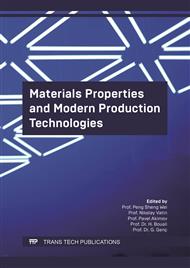[1]
Dykin I.V., Velichko E.G., Eremin A.V., Multilevel Modified Cement Systems, Bulletin of Construction Engineers, 4 (57), 111–114 (2016).
Google Scholar
[2]
Velichko E.G., Belyakova Zh.S., Physicochemical and methodological bases for obtaining multicomponent systems of optimized composition, Stroitelnye materialy, 3, 27-30 (1995).
Google Scholar
[3]
Leng F.F., Destruction of composites with dispersed particles in a brittle matrix, Composite material. Destruction and fatigue,5, (1978).
Google Scholar
[4]
Collepardi M., Self-Compacting Concrete: What is New, Proceedings of Seventh CANMET, ACI International Conference on Superplasticizers and Other Chemical Admixtures in Concrete, 1-16(2003).
DOI: 10.14359/12902
Google Scholar
[5]
Velichko E.G., Shumilina Yu.S., On the problem of the formation of dispersed composition and properties of high-strength concrete. Vestnik MGSU. 2020. No. 2 (2020). Pp. 235-243 DOI: 10.22227 / 1997-0935.2020.2.235-243.
DOI: 10.22227/1997-0935.2020.2.235-243
Google Scholar
[6]
Shesternin A.I., Korovkin M.O., Eroshkina N.A., Fundamentals of Self-Compacting Concrete Technology, Young Scientist, 6, 226-228 (2015).
Google Scholar
[7]
Melikhov I.V., Physicochemical Evolution of Solids (Binom. Laboratory of Knowledge, Moscow, 2009).
Google Scholar
[8]
Yuriev N.B., Highly Concentrated Disperse Systems, (Chemistry, Moscow, 1980).
Google Scholar
[9]
Taraseeva N.I., The role of waste-free technologies in expanding the raw material base to obtain effective modified additives and active fillers in cement mortars and concretes, New University. Technicalsciences, 10 (32), 90-93 (2014).
Google Scholar
[10]
Kalashnikov V.I., The industry of non-metallic building materials and the future of concrete, Building materials, 3, 20-23 (2008).
Google Scholar
[11]
Suzdaltsev O.V., New high-performance concretes, New University. Engineering Science, 7-8 (29-30), 44-47 (2014).
Google Scholar
[12]
Eisenstadt A.M., Elements of surface thermodynamics of highly dispersed rock systems // Collection of the All-Russian scientific conference Building materials science: the present and the future,, dedicated to the 90th anniversary of Yu.M. Bazhenov. 2020.S. 12-17.
Google Scholar
[13]
Danilov V.E., Eisenstadt A.M., Boundary angles of soaking of naphayushikhpots // Collection of the All-Russian scientific conference Building materials science: the present and the future,, dedicated to the 90th anniversary of Yu.M. Bazhenov. 2020.S. 37-42.
Google Scholar
[14]
Isaeva Yu.V., Velichko E.G, Kasumov A.Sh., Structure optimization of ultra-light cement mortar with due regard for geometrical and physicaland mechanical characteristics of components, Construction Materials, 8, 84-87(2015).
Google Scholar
[15]
Yakovlev G.I., Gordin A.F., Polyanskikh I.S., Tokarev Yu. V., Pervushin G.,. Saltykov A.A, Bekmansurov M.R., Directional control of the structure and properties of gypsum compositions, Advanced materials in construction and mechanical engineering, 60-67 (2014).
Google Scholar
[16]
Yakovlev G.I., Ginuchickaya YU.N., Kizinievich O., Kizinievich V., Gordina A.F., Influence of dispersions of multilayer carbon nano-tubes on physical-mechanical characteristics and structure of building ceramics, Construction Materials, 8, 20-29(2016).
Google Scholar
[17]
Rozental' N.K., CHekhnij G.V., Lyubarskaya G.V., Rozental' A.N., Protection of concrete on reactive aggregate from internal corrosion by lithium salt, Construction Materials, 3, 68-73 (2009).
Google Scholar
[18]
Safarov K.B., Stepanova V.F., Regulation of reaction capacity of fillers and increasing sulfate resistanse of concretes by combined use of low-calcium and high-active metakaolin, Construction Materials, 5, 70-73(2016).
Google Scholar
[19]
Entin Z.B., Yudovich B., Multicomponent cements. - Scientific. Tr., Research Institute of the Cement Industry, 107, 3-76 (1994).
Google Scholar
[20]
Akhmetov D.A., Root E.N., Optimization of Self-Compacting Concrete in the Construction Industry of the Republic of Kazakhstan, Young Scientist, 6, 226-228 (2015).
Google Scholar
[21]
Anderson G., Iqbal M.M., Astira I.F., The Effect Of Substitution And Admixture Materials On Self-Compacting Concrete (SCC). Characteristics, International Journal of Scientific& Technology Research, 7(5), 28-33 (2018).
Google Scholar
[22]
Ivanov I.B., Platikanov D.N., Colloids (Chemistry, Leningrad, 1975).
Google Scholar
[23]
Talipov L., Velichko E., Polymer additives for cement systems based on polycarboxylate ethers, Advances in Intelligent Systems and Computing, 939-946(2019).
DOI: 10.1007/978-3-030-19868-8_93
Google Scholar


